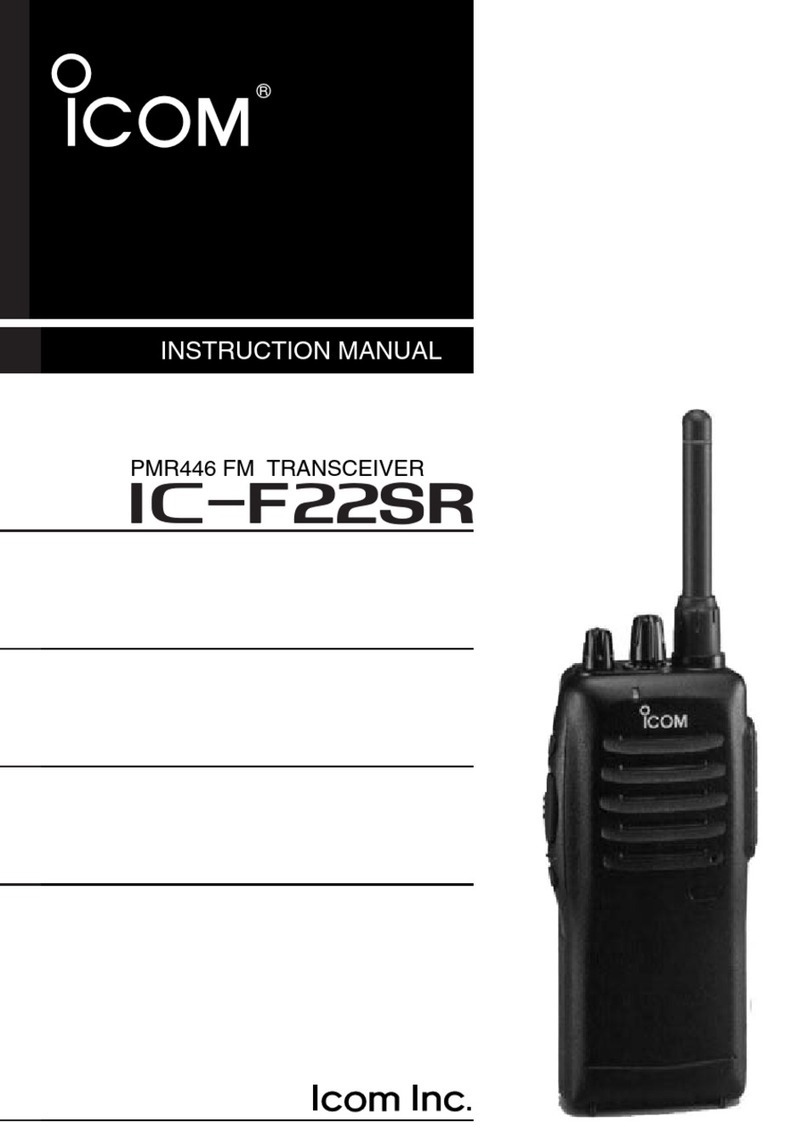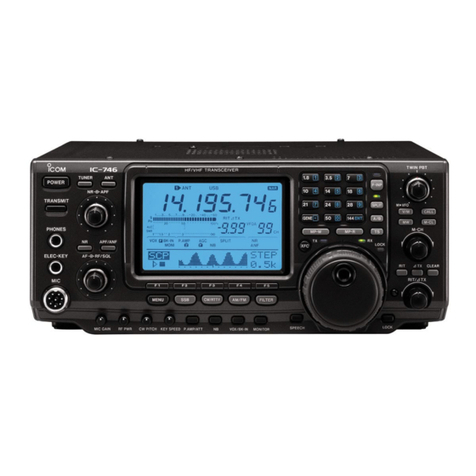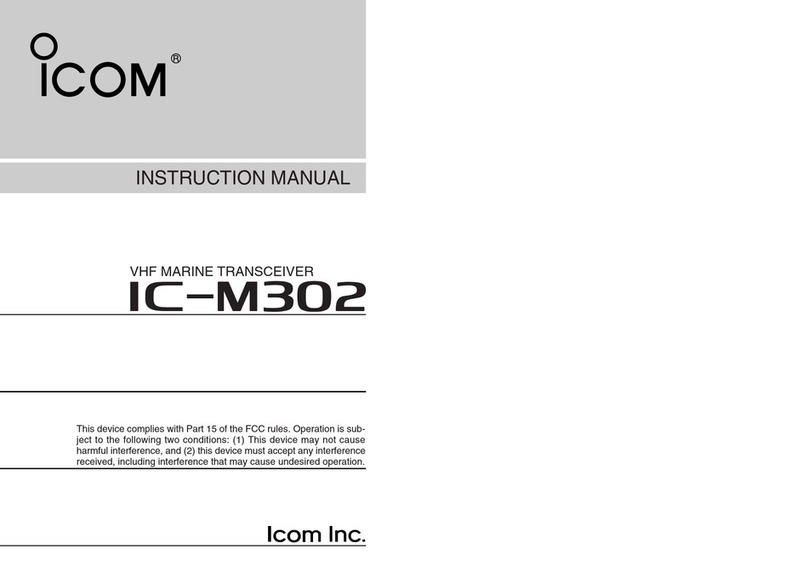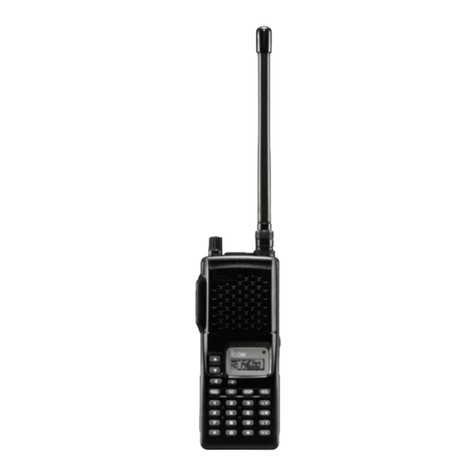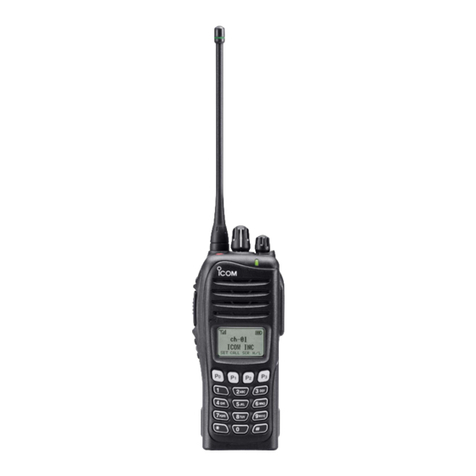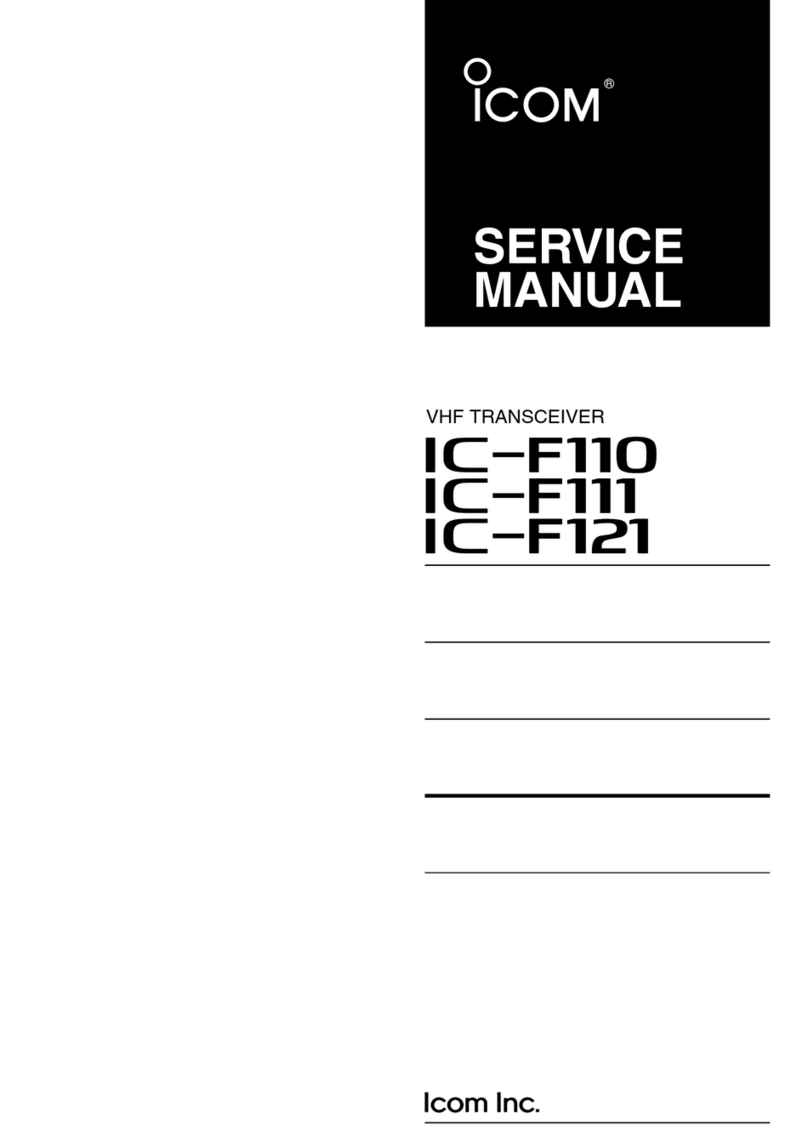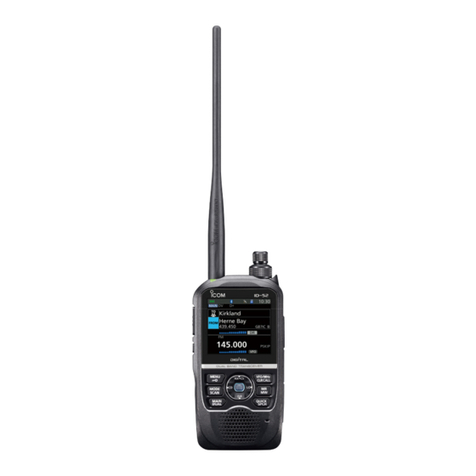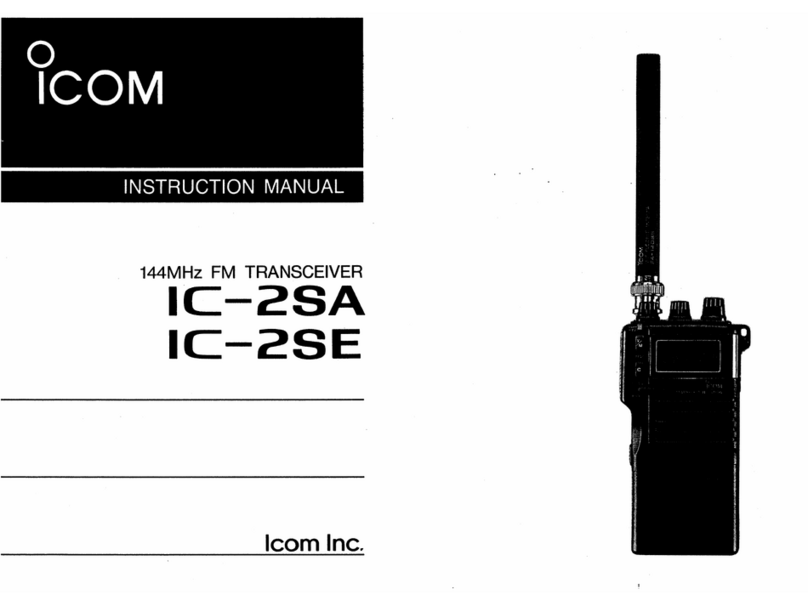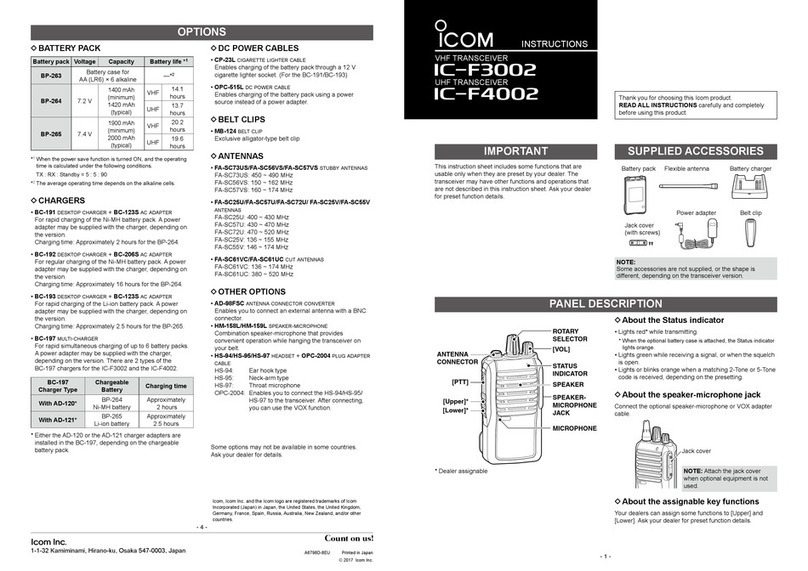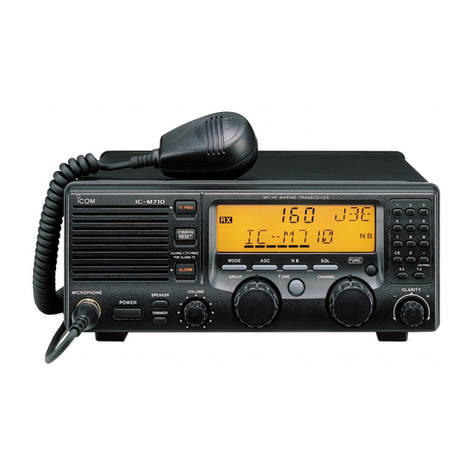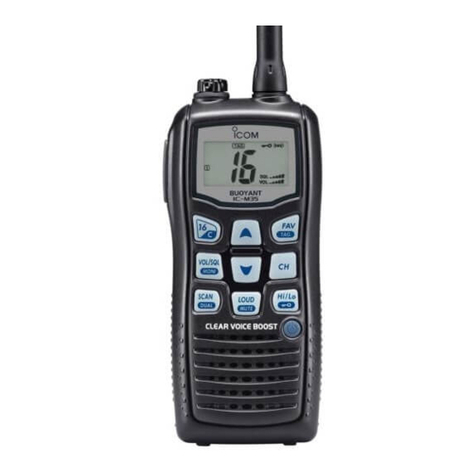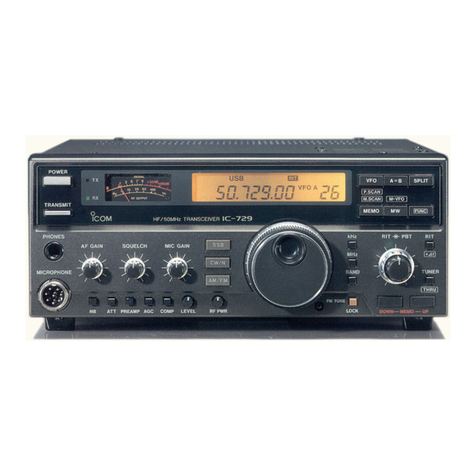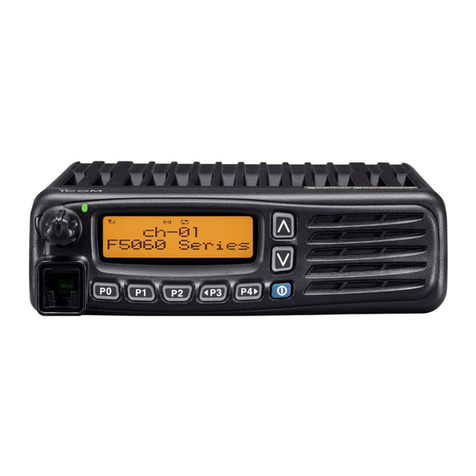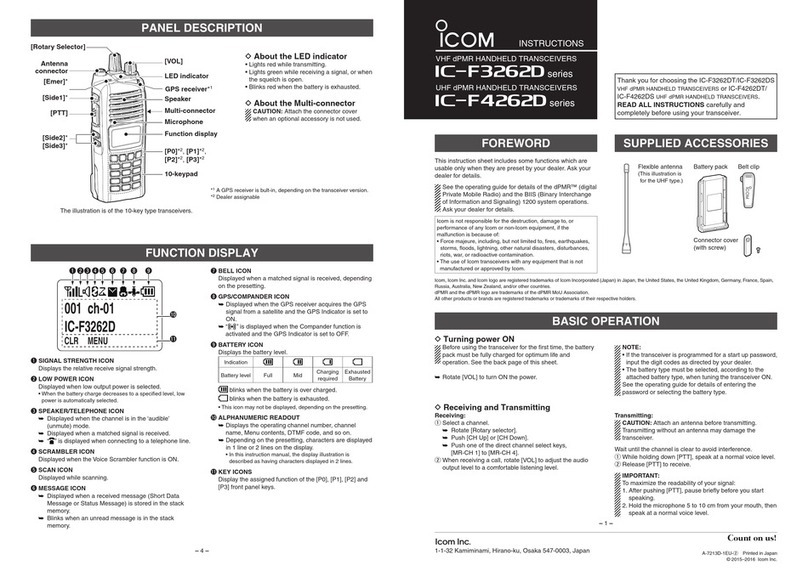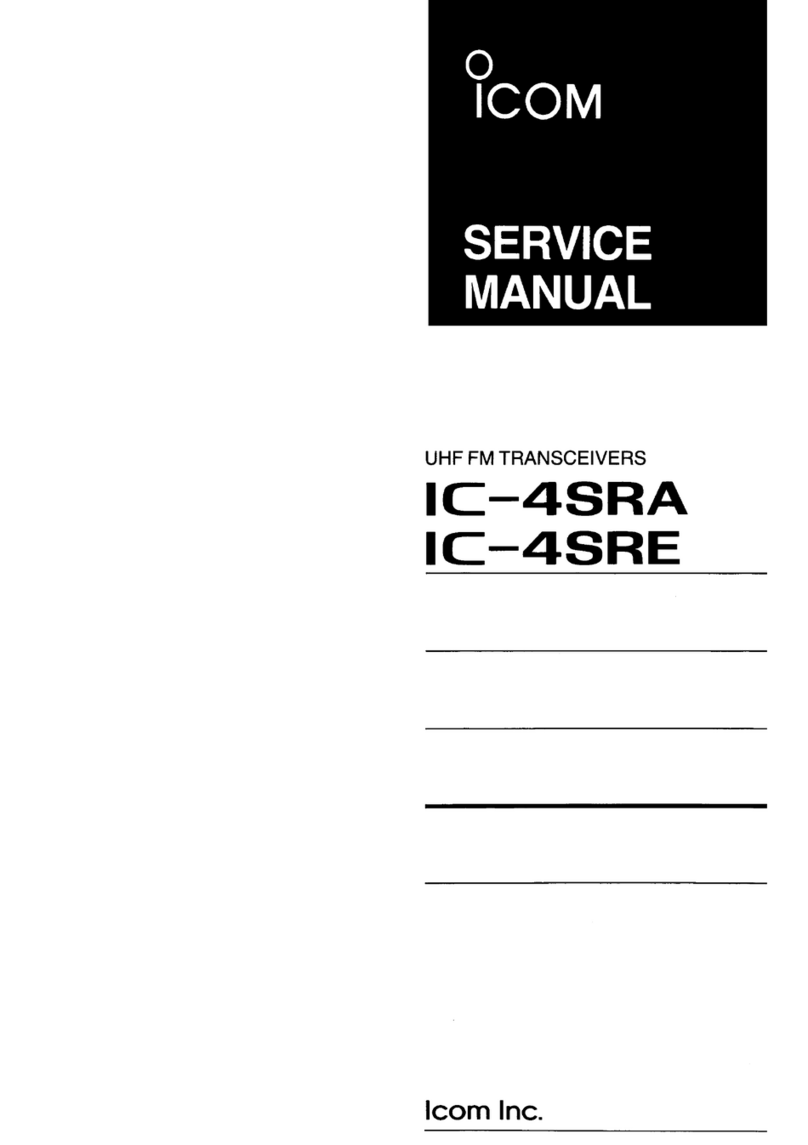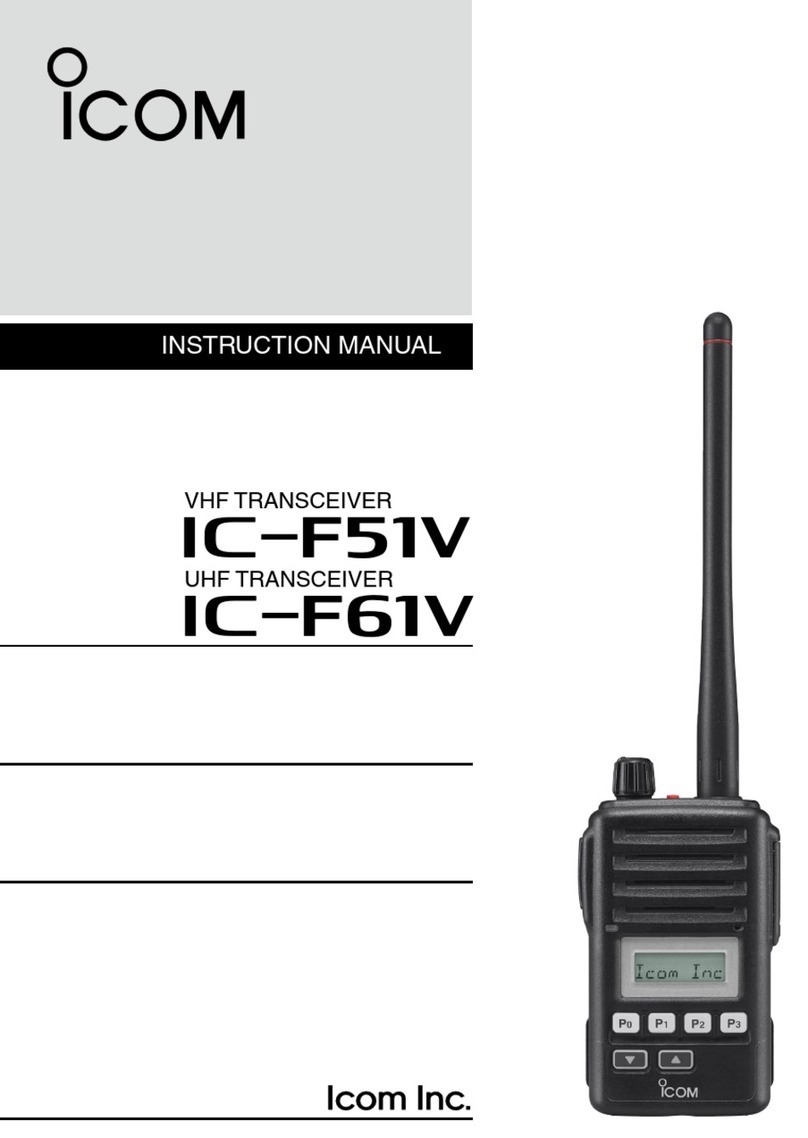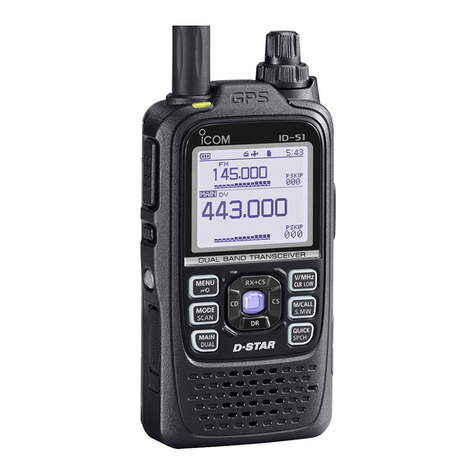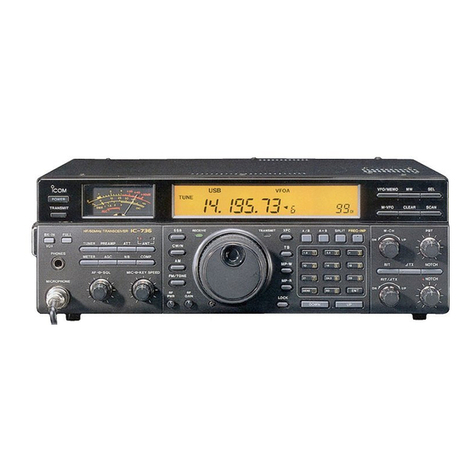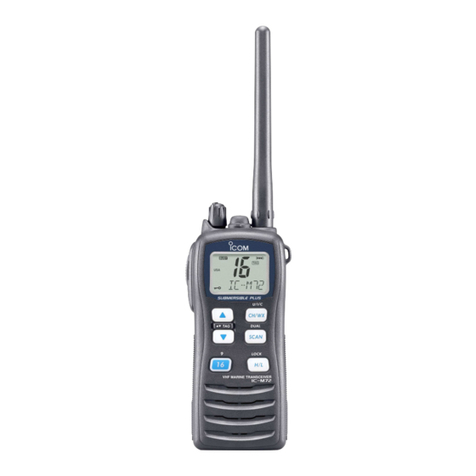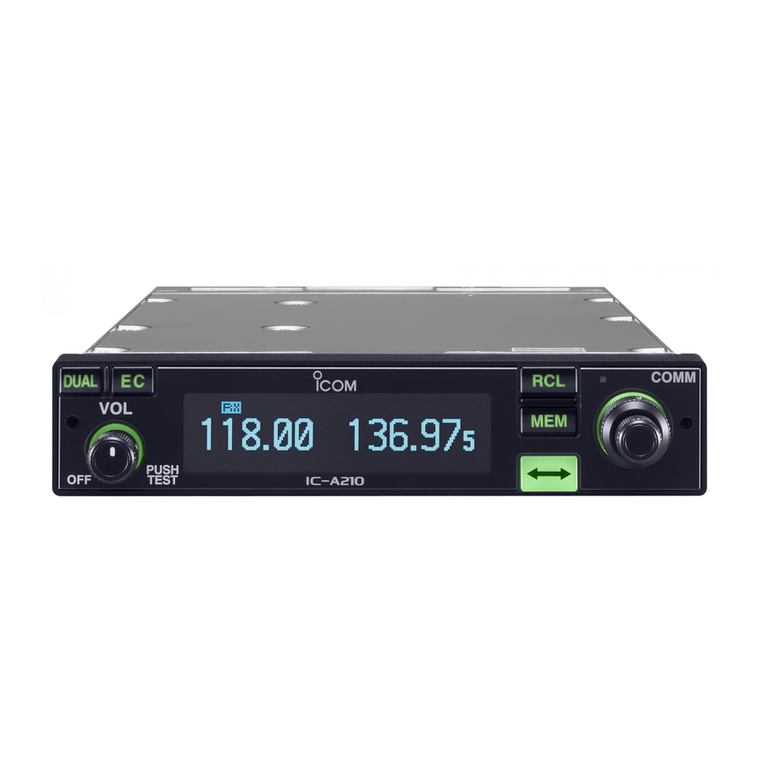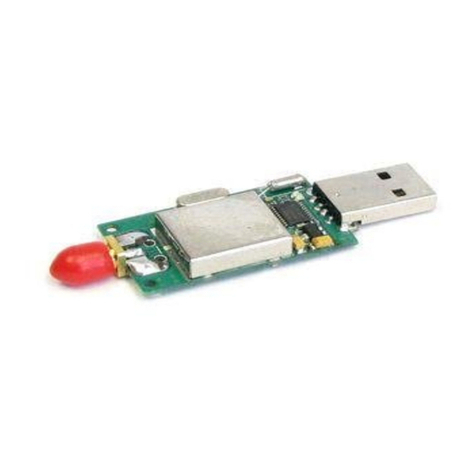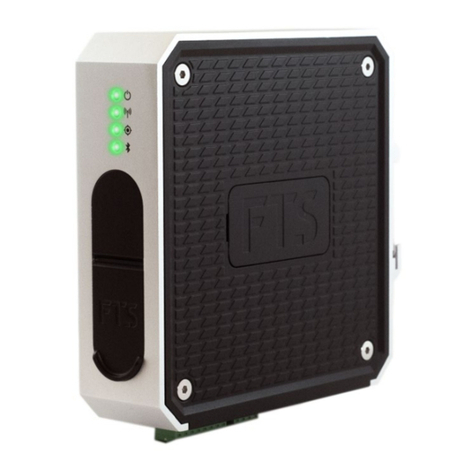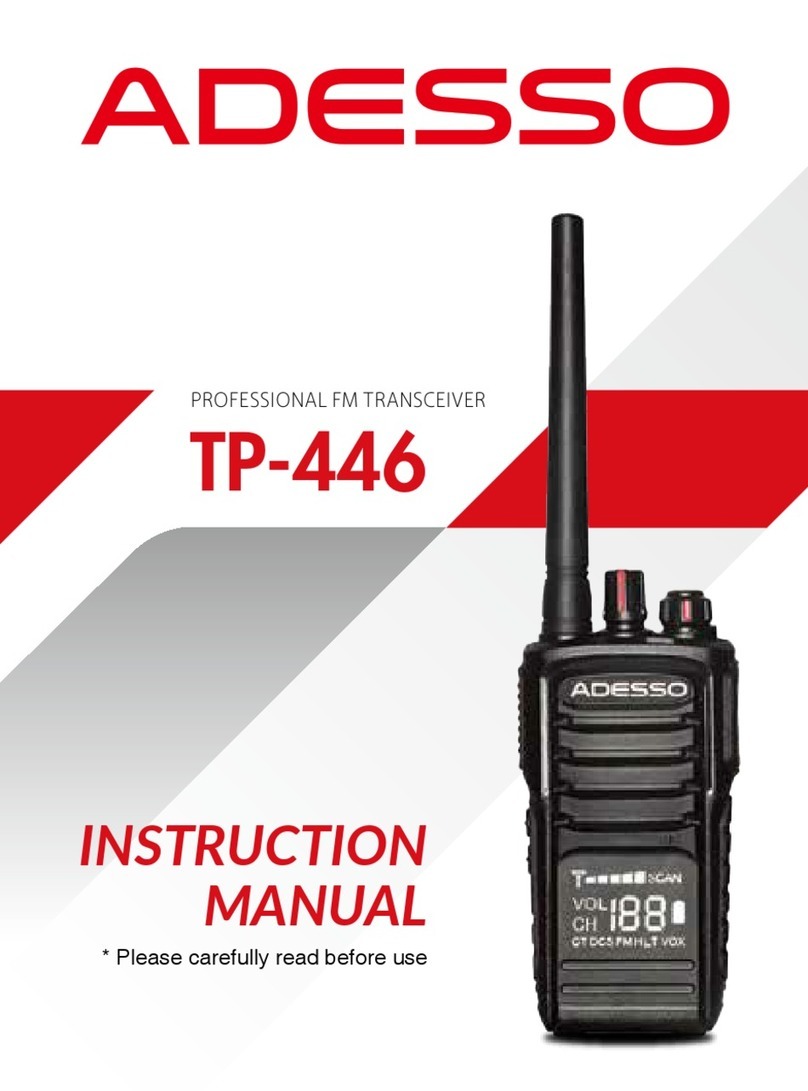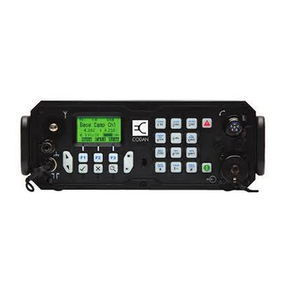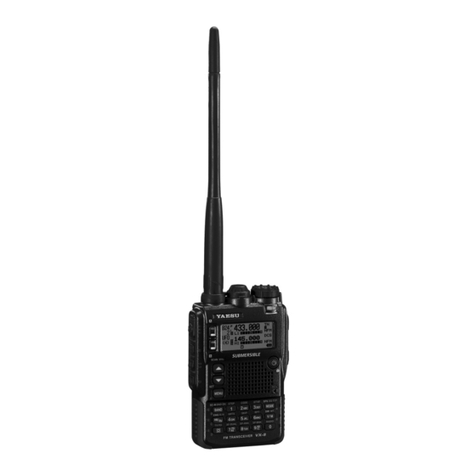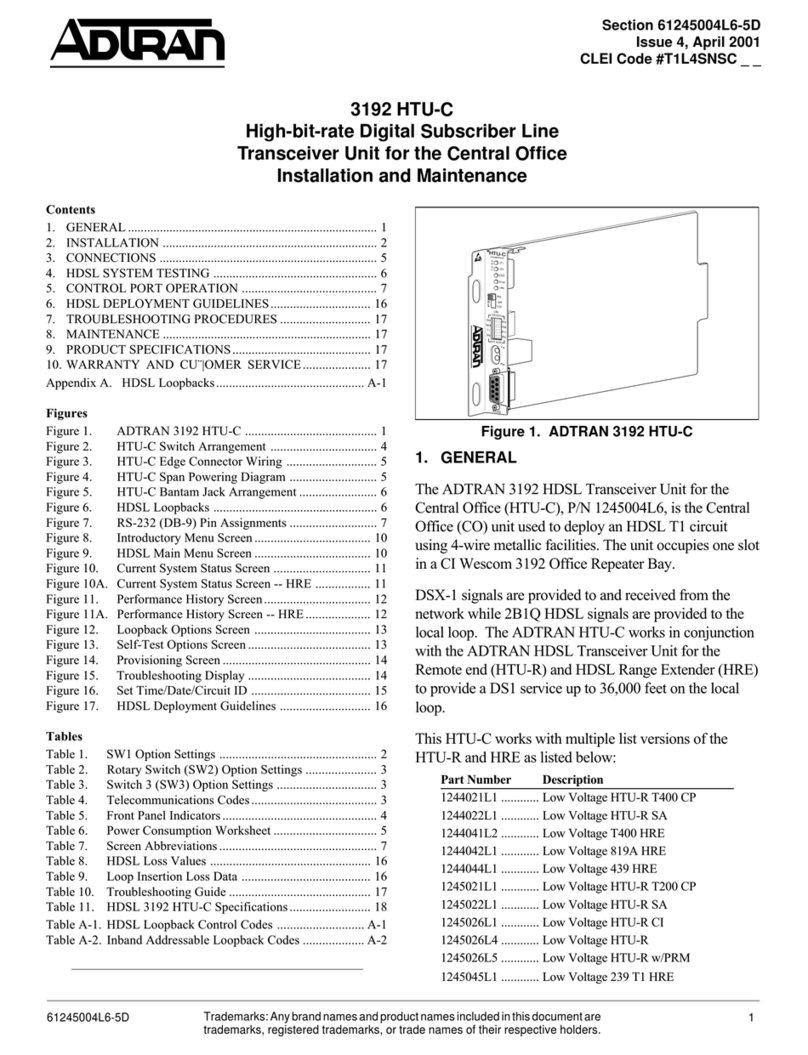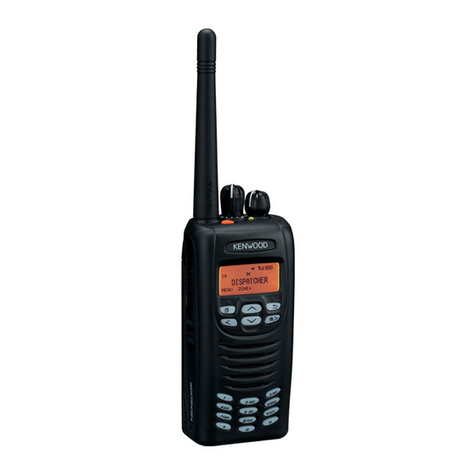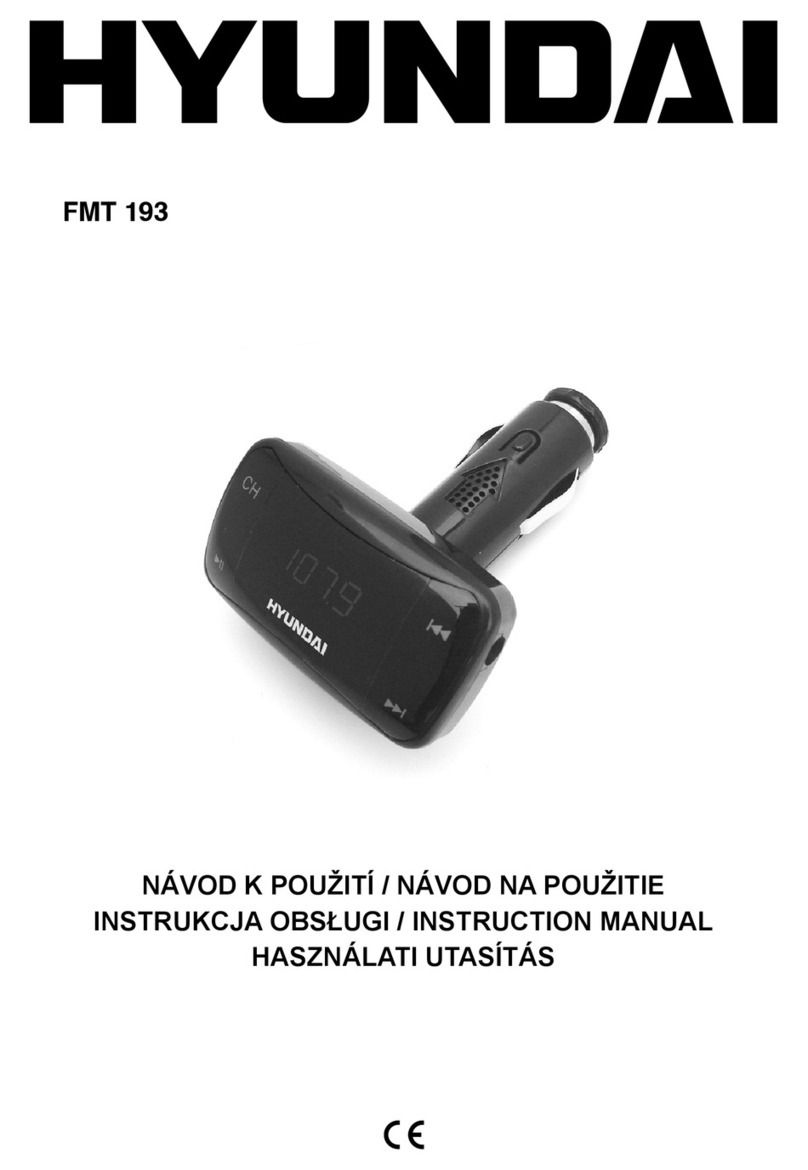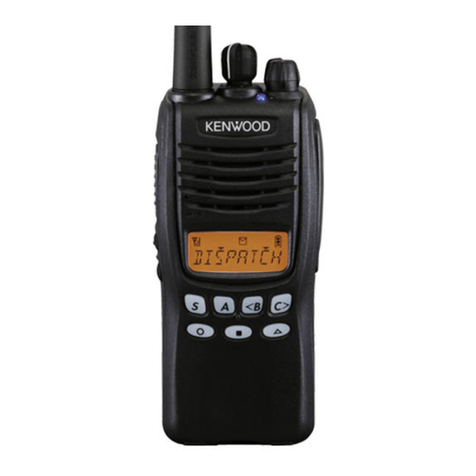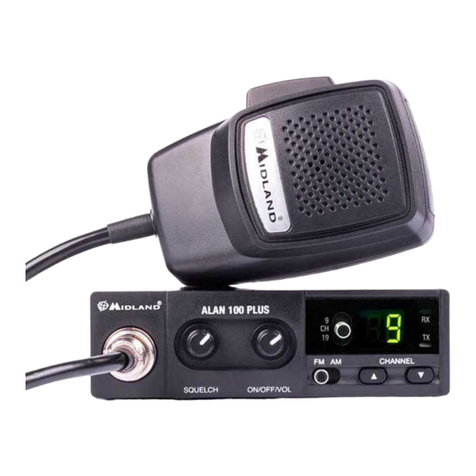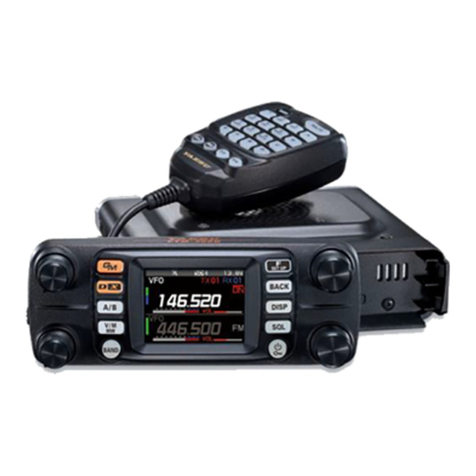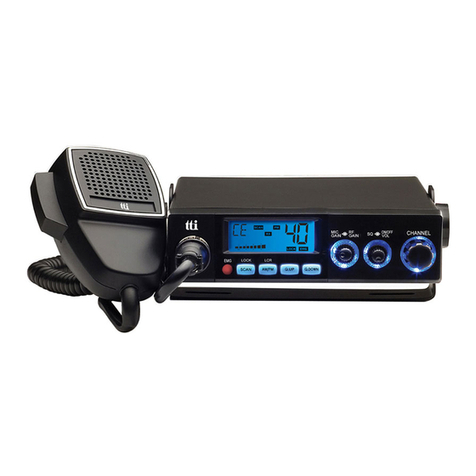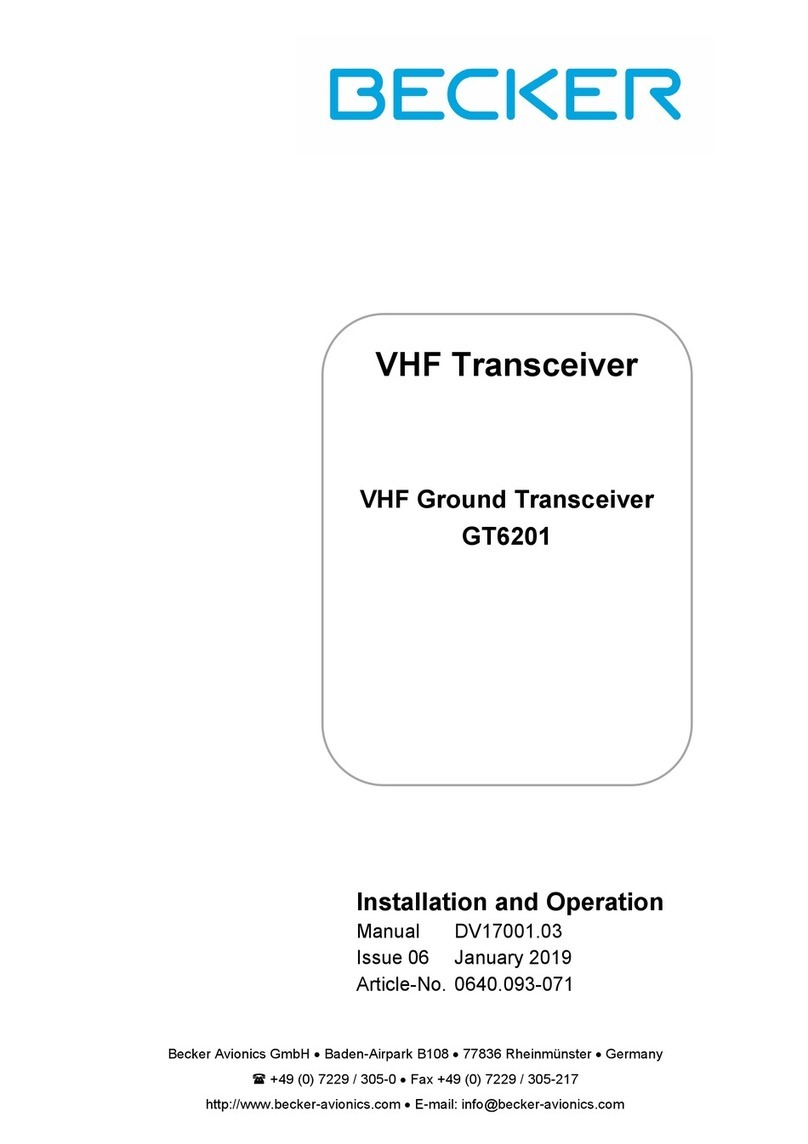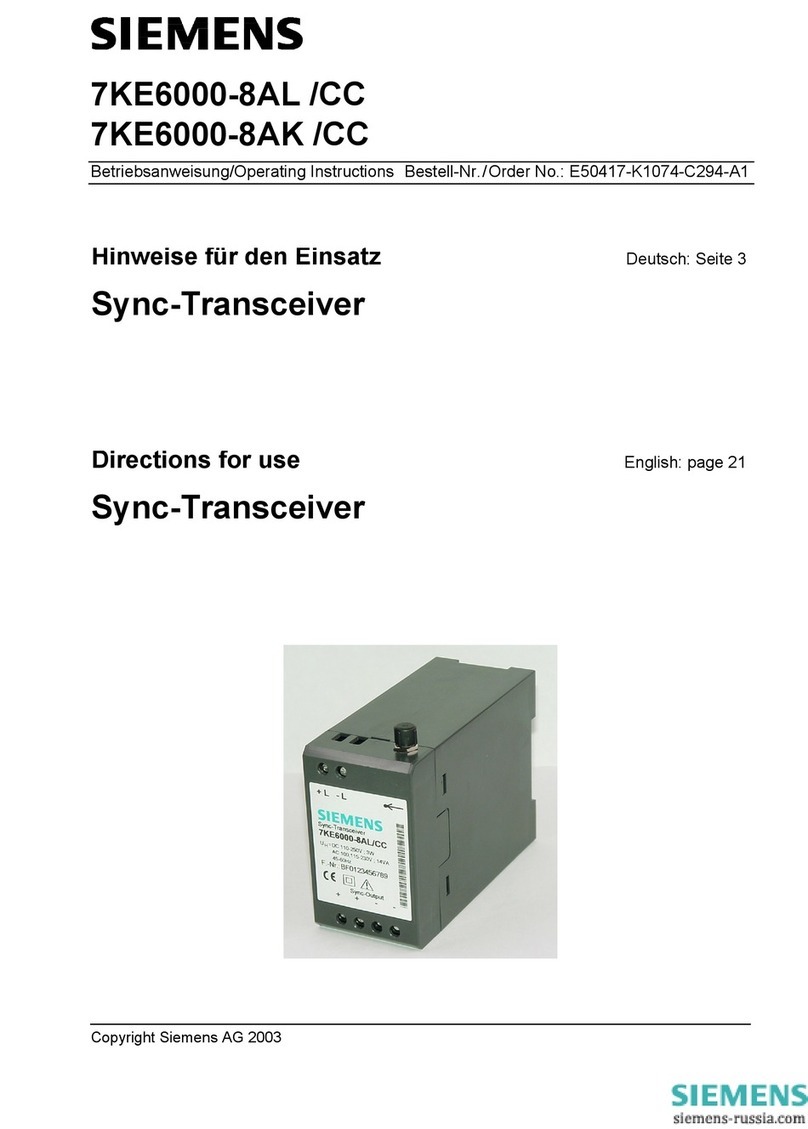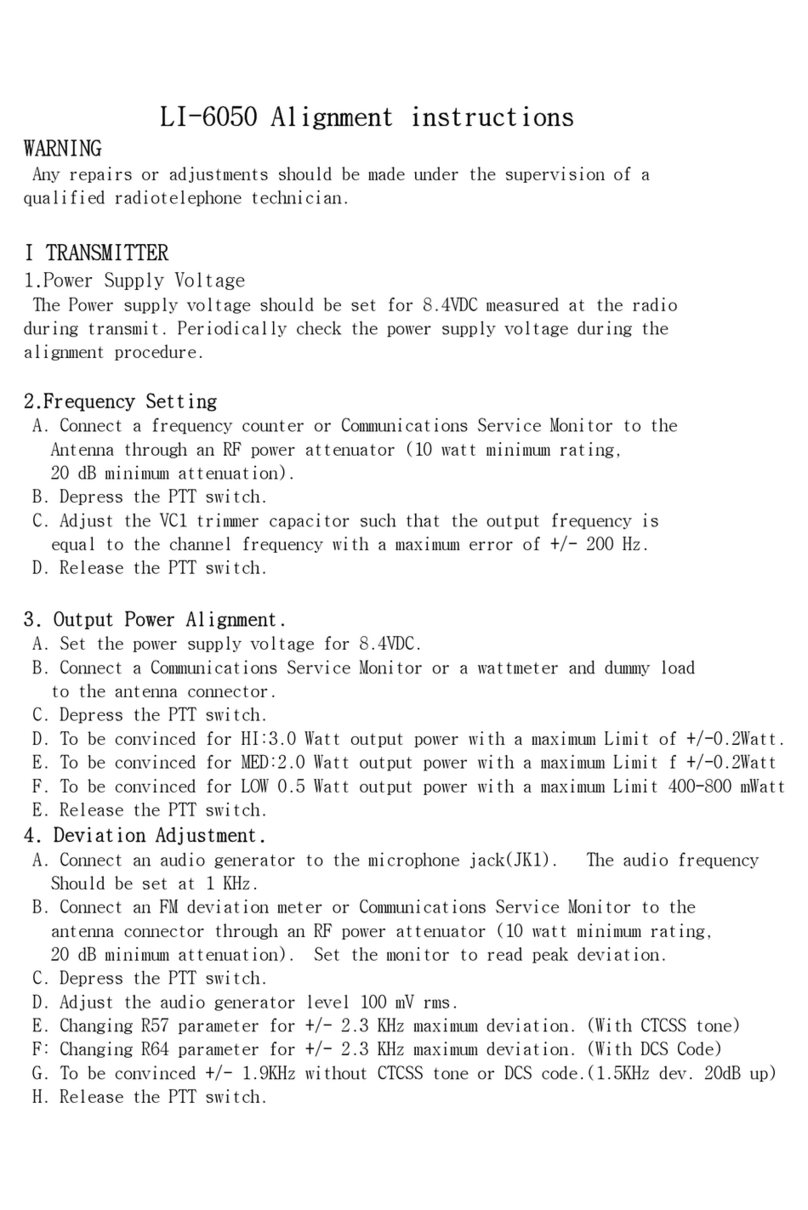Icom IC-F12 User manual

INSTRUCTION MANUAL
UHF TRANSCEIVER
iF22/S
VHF TRANSCEIVER
iF12/S
IC-F12_F22.qxd 03.1.20 14:48 Page 1 (1,1)

i
FOREWORD
Thank you for purchasing the IC-F12/S, F22/S FM transceiver.
READ ALL INSTRUCTIONS carefully and completely before using
the transceiver.
SAVE THIS INSTRUCTION MANUAL–This instruction manual
contains important operating instructions for the transceiver.
IMPORTANT
RCAUTION! NEVER hold the transceiver so that the antenna is
very close to, or touching exposed parts of the body, especially the
face or eyes, while transmitting. The transceiver will perform best if
the microphone is 2 to 4 in. (5 to 10 cm) away from the lips and the
transceiver is vertical.
RCAUTION! NEVER operate the transceiver with a headset or
other audio accessories at high volume levels.
RCAUTION! NEVER short the terminals of the battery pack.
DO NOT push the PTT when not actually desiring to transmit.
AVOID using or placing the transceiver in direct sunlight or in areas
with temperatures below –10°C (+14°F) or above +50°C (+122°F).
DO NOT modify the transceiver for any reason.
KEEP the transceiver from the heavy rain, and Never immerse it in
the water. The transceiver construction is water resistant, not
water proof.
The use of non-Icom battery packs/chargers may impair transceiver
performance and invalidate the warranty.
FCC caution: Changes or modifications to this transceiver, not
expressly approved by Icom Inc., could void your authority to op-
erate this transceiver under FCC regulations.
IC-F12_F22.qxd 03.1.20 14:48 Page 2 (1,1)

ii
TABLE OF CONTENTS
FOREWORD . . . . . . . . . . . . . . . . . . . . . . . . . . . . . . . . . . . . . . . . . . .i
IMPORTANT . . . . . . . . . . . . . . . . . . . . . . . . . . . . . . . . . . . . . . . . . . .i
TABLE OF CONTENTS . . . . . . . . . . . . . . . . . . . . . . . . . . . . . . . . . .ii
1 PANEL DESCRIPTION . . . . . . . . . . . . . . . . . . . . . . . . . . . . . .1–3
‘Switches, controls, keys and connectors . . . . . . . . . . . . . . .1–2
‘LED indicator . . . . . . . . . . . . . . . . . . . . . . . . . . . . . . . . . . . . . .3
2 ACCESSORIES . . . . . . . . . . . . . . . . . . . . . . . . . . . . . . . . . . . . . .4
3 BATTERY PACKS . . . . . . . . . . . . . . . . . . . . . . . . . . . . . . . . .5–11
‘Battery pack replacement . . . . . . . . . . . . . . . . . . . . . . . . . . . .5
‘Battery cautions . . . . . . . . . . . . . . . . . . . . . . . . . . . . . . . . . . . .6
‘Battery charging . . . . . . . . . . . . . . . . . . . . . . . . . . . . . . . . . .7-9
‘ Charging NOTE . . . . . . . . . . . . . . . . . . . . . . . . . . . . . . . . . .10
‘ Battery case (Option) . . . . . . . . . . . . . . . . . . . . . . . . . . . . . .11
44 PPRROOGGRRAAMMMMAABBLLEE FFNNCCTTIIOONNSS .. .. .. .. .. .. .. .. .. .. .. .. .. .. .. .. .. .. .. .. ..12-16
‘General . . . . . . . . . . . . . . . . . . . . . . . . . . . . . . . . . . . . . . . . .12
5 CONVENTIONAL OPERATION . . . . . . . . . . . . . . . . . . . . . .17-18
‘Receiving and transmitting . . . . . . . . . . . . . . . . . . . . . . . . . .17
‘Call procedure . . . . . . . . . . . . . . . . . . . . . . . . . . . . . . . . . . . .18
‘Setting squelch level . . . . . . . . . . . . . . . . . . . . . . . . . . . . . . .19
‘Transmitting notes . . . . . . . . . . . . . . . . . . . . . . . . . . . . . . . . .19
6 CLONING . . . . . . . . . . . . . . . . . . . . . . . . . . . . . . . . . . . . . . . . . .20
7 OPTION . . . . . . . . . . . . . . . . . . . . . . . . . . . . . . . . . . . . . . . . .21-22
8 CE . . . . . . . . . . . . . . . . . . . . . . . . . . . . . . . . . . . . . . . . . . . . .23-25
IC-F12_F22.qxd 03.1.20 14:48 Page 3 (1,1)

1
PANEL DESCRIPTION
1
‘‘Switches, controls, keys and
connectors
y
u
Speaker
Mic
w
e
r
t
i
2CH version
CH1↔CH2
16CH version
CH1 to CH16
q
SP MIC
IC-F12_F22.qxd 03.1.20 14:48 Page 4 (1,1)

2
1
PANEL DESCRIPTION
qCHANNEL SELECTOR/SW [CH]
•2CH version: Toggle the CH switch to select CH1 or CH2.
•16CH version: Turn the selector knob to select the pro-
grammed operating channel.
wVOLUME CONTROL [OFF/VOL]
Turns power ON and adjusts the audio level.
eDEALER-PROGRAMMABLE KEY [Upper]
Can be programmed for one of several functions by your Icom
dealer.
rPTT SWITCH [PTT]
Push and hold to transmit; release to receive.
tDEALER-PROGRAMMABLE KEY [Lower]
Can be programmed for one of several functions by your Icom
dealer.
yANTENNA CONNECTOR
Connects the supplied antenna.
uTX/RX INDICATOR LED (see p. 3)
•Lights red while transmitting.
•Lights green while receiving a signal, or squelch is open.
i[SP]/[MIC] JACK
Connects optional speaker-microphone.
NOTE: Above functions depend on pre-setting.
Red
Upper
Lower
Mic Up*
Mic Down*
Mic A*
Mic B*
DDProgrammable key reference ([Red] depends on version.)
*These functions are available when the optional Speaker/Mic. is con-
nected.
IC-F12_F22.qxd 03.1.20 14:48 Page 5 (1,1)

‘‘LED indicator
The TX/RX indicator LED indicates several
more information as follows;
(Ref.; R=Red, G=Green, O=Orange)
PANEL DESCRIPTION
1
3
R R R R
R R
O O
O O
R R R R
R R
G
G G
R
•TX: Turns Red while transmitting a signal.
•RX: Turns Green while receiving a signal.
•Call LED (ON): When receiving a matched 2/5TONE.
•Call LED (Blink): When receiving a matched 2/5TONE.
•Fast/Slow scan: Blinks while Fast/Slow scan is activated.
•Low BATT1: You should charge the battery. (blinks slowly)
•Low BATT2: You must charge the battery. (blinks fast)
•TX low BATT1: Low BATT1 was detected during TX mode.
•TX low BATT2: Low BATT2 was detected during TX mode.
IC-F12_F22.qxd 03.1.20 14:48 Page 6 (1,1)

2
ACCESSORIES
4
‘‘Accessory attachment
DSupplied accessories
The transceiver comes supplied with the following accessories.
qFlexible antenna
wBelt clip
DAntenna
The antenna screws onto the transceiver as
illustrated right.
DBelt clip
Attach the belt clip to the transceiver as illustrated below.
q
w
IC-F12_F22.qxd 03.1.20 14:48 Page 7 (1,1)

5
3BATTERY PACKS
‘‘Battery pack replacement
Before replacing the battery pack, the volume control MUST be ro-
tated fully counterclockwise,
until a click is heard, to turn the
power OFF.
•Push the battery release for-
ward, then pull the battery
pack upward with the trans-
ceiver facing you.
DDBATTERY PACKS
*1Operating periods are calculated under the following conditions;
Tx : Rx : standby =5 : 5 : 90
*1Operating period depends on the alkaline cells used. (BP-208 only)
*2Output power is automatically reduced to 1 W to retain sufficient power
in case of an emergency, etc.
*3Operating period measured with the 2 W model.
yrettaB
kcap egatloV yticapaC
doirepgnigrahC
gnitarepO
*doirep
1
BC-146
BP-208*
2
AArofesacyretta
B
)6R( ×enilakla6
902-PB V2.7srh21srh5.1srh8
012-PB V2.7 0561
hAm 18.5 hrs srh0.2srh11
1100
mAh
BP-222*
3
V2.7 006
hAm rh1 hrs
5.5*
3
6.5 hrs
BC-144,
BC-119 or
BC-121
IC-F12_F22.qxd 03.1.20 14:48 Page 8 (1,1)

6
3
BATTERY PACKS
‘‘Battery cautions
•CAUTION! NEVER short the terminals of the battery pack (or
charging terminals of the transceiver). Also, current may flow into
nearby metal objects such as a necklace, so be careful when plac-
ing battery packs (or the transceiver) in handbags, etc.
Simply carrying with or placing near metal objects such as a neck-
lace, etc. causes shorting. This will damage not only the battery
pack, but also the transceiver.
•NEVER incinerate used battery packs. Internal battery gas may
cause an explosion.
•NEVER immerse the battery pack in water. If the battery pack be-
comes wet, be sure to wipe it dry BEFORE attaching it to the
transceiver.
•Clean the battery terminals to avoid rust or miss contact.
•Keep battery contacts clean. It’s a good idea to clean battery ter-
minals once a week.
If your battery pack seems to have no capacity even after being
charged, completely discharge them, then fully charge the battery
pack again. If the battery pack still does not retain a charge (or only
very little charge), a new battery pack must be purchased.
DDRecycling information (U.S.A. only)
The battery (BP-209, BP-210 or BP-222) that you
have purchased is recyclable. At the end of its life,
under various state and local laws, it may be illegal
to dispose of this battery into the municipal waste
stream. Call 1-800-822-8837 for battery recycling
options in your area or contact your dealer.
IC-F12_F22.qxd 03.1.20 14:48 Page 9 (1,1)

7
3BATTERY PACKS
‘‘Battery charging
DRapid charging with the BC-144+AD-99
The optional BC-144 provides rapid charging of optional battery
packs.
The following are additionally required:
•One AD-99 (depends on version.).
•An AC adapter (may be supplied with the BC-144 depending on
version).
AC adapter
BC-145A/E/V/UK
BP-209, BP-210
or BP-222 only
Charging indicator
Check orientation.
IC-F12_F22.qxd 03.1.20 14:48 Page 10 (1,1)

8
3
BATTERY PACKS
DRapid charging with the BC-144+AD-99
DDSpacer combination.
•Be sure to attach the
spacer (Spacer B/C) to
the adapter (Spacer A)
with the orientation as il-
lustrated in the diagram at
right.
•Attach the spacer
(Spacer B/C) to the
adapter with the orientation of the stamp “”pointing up.
NOTE: Push the notch carefully
when remove the spacer from the
adapter.
Turn power OFF
BP-209, BP-210
or BP-222 attached
to the transceiver.
AC adaptor
BC-145A/E/V/UK
Charging indicator
Check orientation
and
Spacer A
Spacer B/C
Check orientation
and the spacer com-
bination as follows.
IC-F12_F22.qxd 03.1.20 14:48 Page 11 (1,1)

9
3BATTERY PACKS
DRapid charging with the BC-121N+AD-94 (#11)
The optional BC-121N allows up to 6 battery packs to be charged
simultaneously. The following are additionally required.
•Six AD-94 (#11) (Some versions require additional AD-99s).
•An AC adapter (may be supplied with the BC-121N depending on
version).
DRegular charging with the BC-146
The optional BC-146 pro-
vides regular charging of
optional battery pack with/
without transceiver.
The following is additionally
required:
•An optional AC adapter.
(A charging spacer is sup-
plied with BC-146.)
MULTI-CHARGER
AC adaptor
(purchased
separately)
Charge indicator
(each indicator functions independently)
Turn power OFF.
AD-99
Check orientation
for correct charg-
ing.
(Insert togeth-
er with charging
adapter.)
Turn power OFF.
BC-146
IC-F12_F22.qxd 03.1.20 14:48 Page 12 (1,1)

10
3
BATTERY PACKS
‘‘Charging NOTE
Prior to using the transceiver for the first time, the battery pack must
be fully charged for optimum life and operation.
•Recommended temperature range for charging:
+10°C to +40°C (50°F to 140°F).
•Use the supplied charger or optional charger (BC-119N/BC-
121N/BC-144 for rapid charging, BC-146 for regular charging)
only. NEVER use other manufacturers’chargers.
The optional BP-209, BP-210 or BP-222 battery packs include
rechargeable Ni-Cd(Ni-MH: BP-210) batteries and can be charged
approx. 300 times. Charge the battery pack before first operating
the transceiver or when the battery pack becomes exhausted.
If you want to charge the battery pack more than 300 times, the fol-
lowing points should be observed:
•Avoid overcharging–batteries must be removed from the charger
to stop charging. Batteries should not be charged for more than
15 hours after the LED indicator turns green.
•Use the battery until it becomes almost completely exhausted
under normal conditions.
DDBattery pack life
When the operating period becomes extremely short even after
charging the battery pack fully, a new battery pack is needed.
NOTE: The charger rapidly charges a battery pack to a speci-
fied level, not a completed level, to prevent overcharging. Leave
the battery pack in the charger for a few more hours (up to
15 hours; depending on battery condition) after the LED indica-
tor turns green, to charge the battery completely.
IC-F12_F22.qxd 03.1.20 14:48 Page 13 (1,1)

‘‘Battery case (Option)
When using a BP-208 OPTIONAL BATTERY CASE attached to the
transceiver, install 6 AA (R6) size alkaline batteries as illustrated
below.
NOTE: Output power is automatically reduced to 1 W to retain suffi-
cient power in case of an emergency, etc.
DDCAUTIONS
•Use ALKALINE batteries only.
•Make sure all battery cells are the same brand, type and ca-
pacity.
•Never mix old and new batteries.
Either of the above may cause a fire hazard or damage the
transceiver, if ignored.
•Never incinerate used battery cells since internal battery gas
may cause them to rupture.
•Never expose a detached battery case to water.
If the battery case gets wet, be sure to wipe it dry before using
it.
11
3BATTERY PACKS
IC-F12_F22.qxd 03.1.20 14:48 Page 14 (1,1)

12
4
PROGRAMMABLE FUNCTIONS
‘‘General
In the following explanations, programmable function names are
bracketed, the specific switch used to activate the function depends
on programming.
DDKEY LOCK FUNCTION1/2
This function locks access to all programmable switches (except
the switch assigned for the lock function):
Lock1: All Key Lock function; lockes all keys except Lock, PTT,
CALL, Moni, Emergency keys and Channel selector
SW.
Lock2: Channel selector SW Lock function; lockes all keys ex-
cept Lock, PTT, CALL, Moni and Emergency keys.
Push and hold the [Lock1] or [Lock2] switch for 1 sec. to toggle the
lock function ON and OFF.
•This function may be inhibited on some channels.
DDPRIORITY CHANNEL
This function is used to select a pre-programmed channel at the
push of a switch.
Push the [PrioA], [PrioA(Rewrite)] or [PrioB] switch to select the pri-
ority channel.
•Priority channel is automatically selected.
IC-F12_F22.qxd 03.1.20 14:48 Page 15 (1,1)

13
4PROGRAMMABLE FUNCTIONS
DDSCAN FUNCTION
The scan function allows you to search a pre-programmed group
of channels for signals.
Push the [Scan] switch to start/stop scan.
•Scan pauses on a channel when receiving a signal.
•“Lockout SCAN”(pre-programmed list SCAN) or “Priority SCAN”
can be pre-programmed.
•When the “Power-save function”is activated, the transceiver
checks all pre-programmed channels then returns to the “Power-
save function”again.
DDHIGH/LOW POWER OUTPUT
This function selects high or low power for a channel.
Push the [High/Low] switch to toggle between high and low power.
IC-F12_F22.qxd 03.1.20 14:48 Page 16 (1,1)

4
PROGRAMMABLE FUNCTIONS
14
DDMONITOR AUDIBLE FUNCTION
The monitor function allows you to open the transceiver’s squelch
manually to check whether a channel is busy or not. The trans-
ceiver has 2 conditions for receive standby:
Audible condition:
This condition mutes audio ONLY when
no carrier is present. You can receive (or
monitor) any signals on a channel.
•Push and hold the [Moni], switch to se-
lect the audible condition.
Any audio mute functions are cancelled
while pushing the [Moni] switch.
Inaudible condition:
This condition mutes ALL signals except
those directed to you. Therefore you
should check a channel’s condition (busy
or not) with the monitor function before
transmitting.
•Push the [Moni] switch momentarily to
select the inaudible condition.
DDTALK AROUND
The talk around function changes duplex channels to simplex chan-
nels.
•Duplex allows you to contact your base station, repeaters, etc.
•Simplex allows you to contact other portable transceivers directly
(portable-to-portable contact).
Push the [Talk Around] switch one or more times to toggle the func-
tion ON and OFF.
All signals are
received
Only signals con-
taining the proper
tone are received
IC-F12_F22.qxd 03.1.20 14:48 Page 17 (1,1)

PROGRAMMABLE FUNCTIONS
15
4
DDDTMF TRANSMISSION
This function allows you to send a pre-programmed DTMF code to
control a repeater, open another transceiver’s squelch, etc.
Automatic pre-programmed transmission:
Push the [DTMF Autodial] switch to send a DTMF code.
DDEMERGENCY FUNCTION
The emergency function allows you to send your ID quickly and
easily to your Base Station, etc. in case of emergency.
Push and hold the [Emergency Single/repeat] switch for 1 sec. to
activate the emergency function.
•The transceiver selects a pre-programmed channel, then sends
an emergency signal to your Base Station.
•The pre-programmed channel remains selected until a control sig-
nal is received from the Base Station, or power is turned OFF.
•The emergency call is repeatedly transmitted at pre-programmed
intervals.
DDMR-CH1, MR-CH2, MR-CH3, MR-CH4
This function temporarily allows you to select one of memory CH1
to CH4, when you push the [MR-CH1–4] key.
IC-F12_F22.qxd 03.1.20 14:48 Page 18 (1,1)

4
PROGRAMMABLE FUNCTIONS
16
DDCODE SQUELCH
This conveniently eliminates unwanted audio and is useful in group
activities or security related activities where unwanted output can
be a problem. The function is similar to a CTCSS tone squelch.
In order to use the above functions, cloning is necessary via a PC
using the optional CS-F11 cloning software. Using this software, the
transceiver’s model, individual RX Code CH, TX Code CH, Special
Tone Link2 (must be ‘E’) in 5Tone screen, 5Tone Signaling Form in
Memory-CH screen, Log, RX C-No, Key&Display, Common Au-
toReset TimerB, and other settings related to operation can be set.
Refer to the HELP file that comes with the CS-F11 CLONING SOFT-
WARE for available settings.
IC-F12_F22.qxd 03.1.20 14:48 Page 19 (1,1)

17
5CONVENTIONAL OPERATION
‘‘Receiving and transmitting
NOTE: Transmitting without an antenna may damage the trans-
ceiver. See p.4 for antenna attachment.
Turn power ON as described on p. 2.
Receiving:
qSelect a desired channel.
wListen for a transmission and adjust [VOL] to a comfortable lis-
tening level.
•When no transmission is heard, push and hold [Moni] (moni-
tor) while adjusting [VOL] (your transceiver may not be pro-
grammed with the monitor function).
The transceiver is now set to receive desired calls on the selected
channel.
Transmitting:
Wait for the channel to become clear to avoid interference.
eWhile pushing and holding [PTT], speak into the microphone at a
normal voice level.
•When a tone signalling system is used, the call procedure de-
scribed at right may be necessary.
rRelease [PTT] to return to receive.
IMPORTANT: To maximize the readability of your transmitted sig-
nal, pause a few sec. after pushing [PTT], hold the microphone 10
to 15 cm from your mouth and speak at a normal voice level.
IC-F12_F22.qxd 03.1.20 14:48 Page 20 (1,1)
This manual suits for next models
3
Table of contents
Other Icom Transceiver manuals
